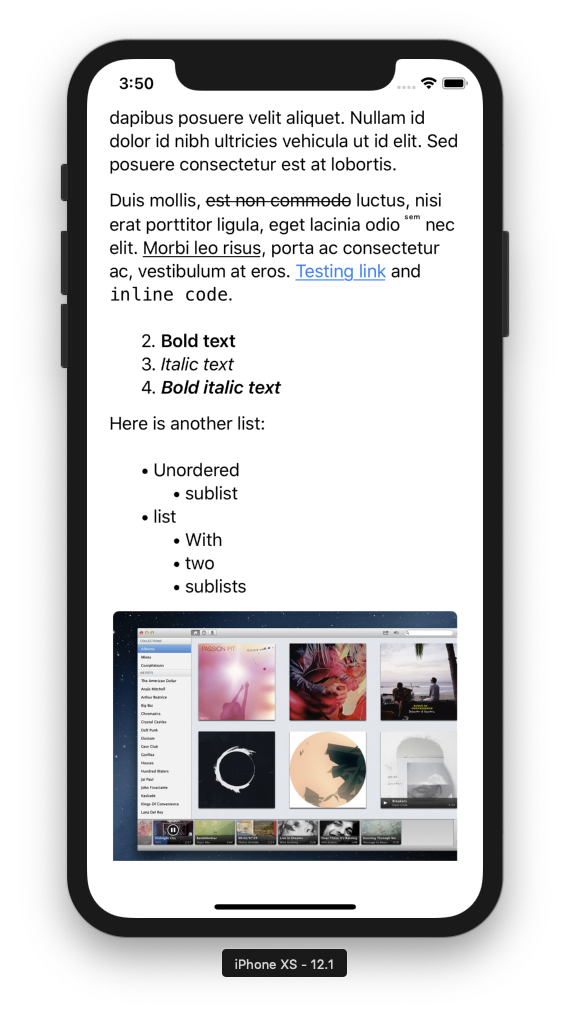CocoaMarkdown is a cross-platform framework for parsing and rendering Markdown, built on top of the C reference implementation of CommonMark.
CocoaMarkdown aims to solve two primary problems better than existing libraries:
- More flexibility. CocoaMarkdown allows you to define custom parsing hooks or even traverse the Markdown AST using the low-level API.
- Efficient
NSAttributedStringcreation for easy rendering on iOS and macOS. Most existing libraries just generate HTML from the Markdown, which is not a convenient representation to work with in native apps.
First you will want to add this project as a submodule to your project:
git submodule add https://github.com/indragiek/CocoaMarkdown.git
Then, you need to pull down all of its dependencies.
cd CocoaMarkdown
git submodule update --init --recursive
Next, drag the .xcodeproj file from within CocoaMarkdown into your project. After that, click on the General tab of your target. Select the plus button under "Embedded Binaries" and select the CocoaMarkdown.framework.
CMNode and CMIterator wrap CommonMark's C types with an object-oriented interface for traversal of the Markdown AST.
let document = CMDocument(contentsOfFile: path, options: [])
document.rootNode.iterator().enumerateUsingBlock { (node, _, _) in
print("String value: \(node.stringValue)")
}The CMParser class isn't really a parser (it just traverses the AST), but it defines an NSXMLParser-style delegate API that provides handy callbacks for building your own renderers:
@protocol CMParserDelegate <NSObject>
@optional
- (void)parserDidStartDocument:(CMParser *)parser;
- (void)parserDidEndDocument:(CMParser *)parser;
...
- (void)parser:(CMParser *)parser foundText:(NSString *)text;
- (void)parserFoundHRule:(CMParser *)parser;
...
@endCMAttributedStringRenderer is an example of a custom renderer that is built using this API.
CMAttributedStringRenderer is the high level API that will be useful to most apps. It creates an NSAttributedString directly from Markdown, skipping the step of converting it to HTML altogether.
Going from a Markdown document to rendering it on screen is as easy as:
let document = CMDocument(contentsOfFile: path, options: [])
let renderer = CMAttributedStringRenderer(document: document, attributes: CMTextAttributes())
textView.attributedText = renderer.render()Or, using the convenience method on CMDocument:
textView.attributedText = CMDocument(contentsOfFile: path, options: []).attributedStringWithAttributes(CMTextAttributes())HTML elements can be supported by implementing CMHTMLElementTransformer. The framework includes several transformers for commonly used tags:
Transformers can be registered with the renderer to use them:
let document = CMDocument(contentsOfFile: path, options: [])
let renderer = CMAttributedStringRenderer(document: document, attributes: CMTextAttributes())
renderer.registerHTMLElementTransformer(CMHTMLStrikethroughTransformer())
renderer.registerHTMLElementTransformer(CMHTMLSuperscriptTransformer())
textView.attributedText = renderer.render()All attributes used to style the text are customizable using the CMTextAttributes class.
Every Markdown element type can be customized using the corresponding CMStyleAttributes property in CMTextAttributes, defining 3 different kinds of attributes:
- String attributes, i.e. regular NSAttributedString attributes
- Font attributes, for easy font setting
- Paragraph attributes, relevant only for block elements
Attributes for any Markdown element kind can be directly set:
let textAttributes = CMTextAttributes()
textAttributes.linkAttributes.stringAttributes[NSAttributedString.Key.backgroundColor] = UIColor.yellowA probably better alternative for style customization is to use grouped attributes setting methods available in CMTextAttributes:
let textAttributes = CMTextAttributes()
// Set the text color for all headers
textAttributes.addStringAttributes([ .foregroundColor: UIColor(red: 0.0, green: 0.446, blue: 0.657, alpha: 1.0)],
forElementWithKinds: .anyHeader)
// Set a specific font + font-traits for all headers
let boldItalicTrait: UIFontDescriptor.SymbolicTraits = [.traitBold, .traitItalic]
textAttributes.addFontAttributes([ .family: "Avenir Next" ,
.traits: [ UIFontDescriptor.TraitKey.symbolic: boldItalicTrait.rawValue]],
forElementWithKinds: .anyHeader)
// Set specific font traits for header1 and header2
textAttributes.setFontTraits([.weight: UIFont.Weight.heavy],
forElementWithKinds: [.header1, .header2])
// Center block-quote paragraphs
textAttributes.addParagraphStyleAttributes([ .alignment: NSTextAlignment.center.rawValue],
forElementWithKinds: .blockQuote)
// Set a background color for code elements
textAttributes.addStringAttributes([ .backgroundColor: UIColor(white: 0.9, alpha: 0.5)],
forElementWithKinds: [.inlineCode, .codeBlock])List styles can be customized using dedicated paragraph style attributes:
// Customize the list bullets
textAttributes.addParagraphStyleAttributes([ .listItemBulletString: "🍏" ],
forElementWithKinds: .unorderedList)
textAttributes.addParagraphStyleAttributes([ .listItemBulletString: "🌼" ],
forElementWithKinds: .unorderedSublist)
// Customize numbered list item labels format and distance between label and paragraph
textAttributes.addParagraphStyleAttributes([ .listItemNumberFormat: "(%02ld)",
.listItemLabelIndent: 30 ],
forElementWithKinds: .orderedList)Font and paragraph attributes are incremental, meaning that they allow to modify only specific aspects of the default rendering styles.
Additionally on iOS, Markdown elements styled using the font attributes API get automatic Dynamic-Type compliance in the generated attributed string, just like default rendering styles.
CMHTMLRenderer provides the ability to render HTML from Markdown:
let document = CMDocument(contentsOfFile: path, options: [])
let renderer = CMHTMLRenderer(document: document)
let HTML = renderer.render()Or, using the convenience method on CMDocument:
let HTML = CMDocument(contentsOfFile: path).HTMLString()The project includes example apps for iOS and macOS to demonstrate rendering attributed strings.
- Indragie Karunaratne
- @indragie
- http://indragie.com
CocoaMarkdown is licensed under the MIT License. See LICENSE for more information.

